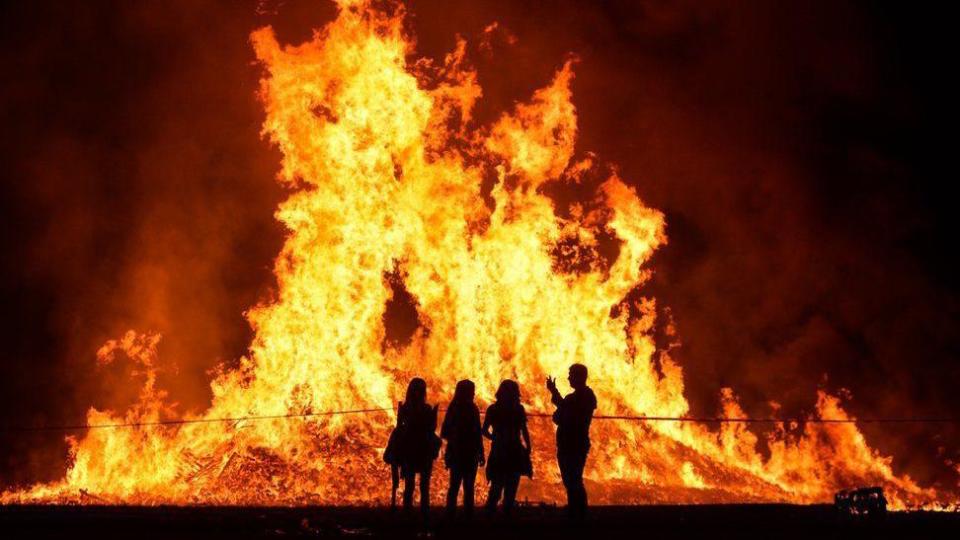Why are bonfires lit over the Twelfth?
On 11 July, bonfires will be lit across Northern Ireland, but why are they lit? And where can you see them?
Bonfires are lit in some unionist areas on 11 July to kick off the Twelfth celebrations.
The date commemorates the Battle of the Boyne in 1690 when the Protestant King William III - also known as King Billy and William of Orange - defeated Catholic King James II.
Bonfires were lit to welcome - and guide - William.
Historically, a much smaller number of bonfires were lit in mainly nationalist areas on 15 August to mark the Catholic feast of the Assumption, a tradition that was replaced in some places by bonfires to mark the anniversary of the introduction of internment - or detention without trial - on 9 August 1971.
When are the bonfires lit?

Most bonfires are lit at about midnight heading into 12 July.
However, some are lit as early as 21:00 BST on 11 July and as late as 02:30 BST on 12 July.
The earlier times are to allow more members of the community to attend and limit the noise and disturbance in the early hours of the morning.
Smaller children's bonfires and events, which often include bouncy castles, local bands, games and music, run earlier in the day near most bonfires.
Are bonfires legal in Northern Ireland?
While there no specific laws aimed directly at bonfires, legislation about things such as the environment, pollution, blocking roads and fly-tipping do apply.
Local authorities, the Department for Infrastructure, the Police Service of Northern Ireland (PSNI), the Northern Ireland Environment Agency (NIEA) and the Northern Ireland Fire and Rescue Service (NIFRS) all have different powers they can use to regulate bonfires.
Councils can also take action under a number of different pieces of legislation, including penalties for littering.
Why are some bonfires controversial?
Some people object to loyalist bonfires being used as a form of cultural expression, particularly when they involve the burning of flags, effigies and election posters.
In 2022, the Reverend Mervyn Gibson, the grand secretary of the Orange Order, condemned the burning of effigies on bonfires.
Last year, Sinn Féin's deputy leader Michelle O'Neill told people using effigies on bonfires to "catch themselves on".
In 2023, 11 paramedics were attacked on the night of 11 July and early hours of 12 July.
The assaults occurred at four locations , three of them bonfire sites, with the most serious incident at one bonfire in Carrickfergus involving five paramedics.
The bonfires can raise tensions if they are located close to nationalist areas.
There is also the issue of safety if bonfires are close to people and properties, as well as their environmental impact.
Where is the biggest bonfire?
The largest bonfire in recent years has been in the Craigyhill estate in Larne, with its height in 2023 reported to be about 210ft (64m).
Traditionally bonfires were much smaller but there were a lot more of them.
They were largely built on street corners or waste ground in loyalist areas.
But in recent years, communities have joined together to consolidate their resources to form much larger bonfires, often due to a lack of space.
For some bonfires, the increased size is due to friendly rivalry between communities in a race to build the biggest bonfire.
Are there environmental concerns with bonfires?
Bonfires are largely constructed from wooden pallets and household waste but old tyres are sometimes placed in the pyre, and these release toxic fumes when burned.
More eco-friendly beacons have been appearing around Northern Ireland in the last few years.
These are smaller, pyramid-shaped steel structures, which are pre-filled with a carbon neutral willow wood. They stand on a bed of sand to avoid damage to roads and surfaces, and are designed to be reusable.
Not everyone is a fan of them, though.
While beacons are arguably safer and environmentally friendlier, collecting materials for the bonfire and helping build it has been a long-standing and proud tradition among many families and communities.
Bonfire safety
In the building and lighting of bonfires, safety has been an issue.
In 2023, The Northern Ireland Fire and Rescue Service (NIFRS) attended 34 bonfire-related incidents and said "no bonfire is totally safe".
In 2022, John Steele died after falling off a bonfire he was helping to build.
Mid and East Antrim Borough Council is facing legal action over the death and plans to engage with the community to improve safety.
Bonfire builders in Larne have said they applied numerous safety procedures before allowing a parachute jump from their bonfire on Monday night.
Who pays for them?
Communities collect for bonfires months in advance - both financially and physically.
Most fundraise for local charities or causes and organise family fun days in the run-up to the bonfire being lit.
While a number are self-funded, some avail of council and government funding through cultural expression grants.
They come with stipulations such as not displaying paramilitary symbols or burning flags, effigies or tyres.


